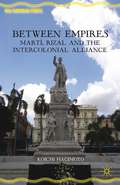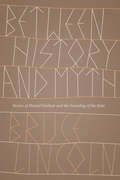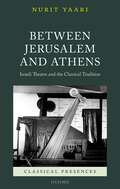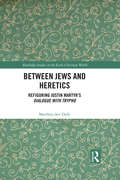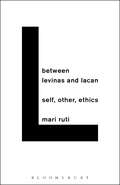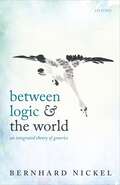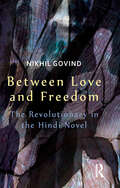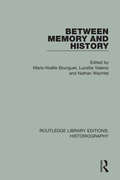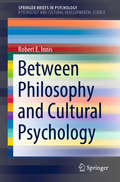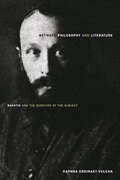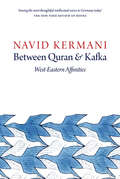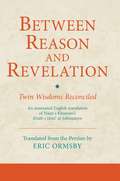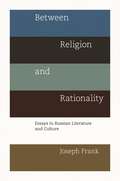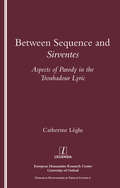- Table View
- List View
Between Empires: Martí, Rizal, and the Intercolonial Alliance (New Caribbean Studies)
by Koichi HagimotoIn 1898, both Cuba and the Philippines achieved their independence from Spain and then immediately became targets of US expansionism. This book presents a comparative analysis of late-nineteenth-century literature and history in Cuba and the Philippines, focusing on the writings of José Martí and José Rizal to reveal shared anti-imperial struggles.
Between History and Myth: Stories of Harald Fairhair and the Founding of the State
by Bruce LincolnAll groups tell stories about their beginnings. Such tales are oft-repeated, finely wrought, and usually much beloved. Among those institutions most in need of an impressive creation account is the state: it’s one of the primary ways states attempt to legitimate themselves. But such founding narratives invite revisionist retellings that modify details of the story in ways that undercut, ironize, and even ridicule the state’s ideal self-representation. Medieval accounts of how Norway was unified by its first king provide a lively, revealing, and wonderfully entertaining example of this process. Taking the story of how Harald Fairhair unified Norway in the ninth century as its central example, Bruce Lincoln illuminates the way a state’s foundation story blurs the distinction between history and myth and how variant tellings of origin stories provide opportunities for dissidence and subversion as subtle—or not so subtle—modifications are introduced through details of character, incident, and plot structure. Lincoln reveals a pattern whereby texts written in Iceland were more critical and infinitely more subtle than those produced in Norway, reflecting the fact that the former had a dual audience: not just the Norwegian court, but also Icelanders of the twelfth and thirteenth centuries, whose ancestors had fled from Harald and founded the only non-monarchic, indeed anti-monarchic, state in medieval Europe. Between History and Myth will appeal not only to specialists in Scandinavian literature and history but also to anyone interested in memory and narrative.
Between History and Myth: Stories of Harald Fairhair and the Founding of the State
by Bruce LincolnAll groups tell stories about their beginnings. Such tales are oft-repeated, finely wrought, and usually much beloved. Among those institutions most in need of an impressive creation account is the state: it’s one of the primary ways states attempt to legitimate themselves. But such founding narratives invite revisionist retellings that modify details of the story in ways that undercut, ironize, and even ridicule the state’s ideal self-representation. Medieval accounts of how Norway was unified by its first king provide a lively, revealing, and wonderfully entertaining example of this process. Taking the story of how Harald Fairhair unified Norway in the ninth century as its central example, Bruce Lincoln illuminates the way a state’s foundation story blurs the distinction between history and myth and how variant tellings of origin stories provide opportunities for dissidence and subversion as subtle—or not so subtle—modifications are introduced through details of character, incident, and plot structure. Lincoln reveals a pattern whereby texts written in Iceland were more critical and infinitely more subtle than those produced in Norway, reflecting the fact that the former had a dual audience: not just the Norwegian court, but also Icelanders of the twelfth and thirteenth centuries, whose ancestors had fled from Harald and founded the only non-monarchic, indeed anti-monarchic, state in medieval Europe. Between History and Myth will appeal not only to specialists in Scandinavian literature and history but also to anyone interested in memory and narrative.
Between History and Myth: Stories of Harald Fairhair and the Founding of the State
by Bruce LincolnAll groups tell stories about their beginnings. Such tales are oft-repeated, finely wrought, and usually much beloved. Among those institutions most in need of an impressive creation account is the state: it’s one of the primary ways states attempt to legitimate themselves. But such founding narratives invite revisionist retellings that modify details of the story in ways that undercut, ironize, and even ridicule the state’s ideal self-representation. Medieval accounts of how Norway was unified by its first king provide a lively, revealing, and wonderfully entertaining example of this process. Taking the story of how Harald Fairhair unified Norway in the ninth century as its central example, Bruce Lincoln illuminates the way a state’s foundation story blurs the distinction between history and myth and how variant tellings of origin stories provide opportunities for dissidence and subversion as subtle—or not so subtle—modifications are introduced through details of character, incident, and plot structure. Lincoln reveals a pattern whereby texts written in Iceland were more critical and infinitely more subtle than those produced in Norway, reflecting the fact that the former had a dual audience: not just the Norwegian court, but also Icelanders of the twelfth and thirteenth centuries, whose ancestors had fled from Harald and founded the only non-monarchic, indeed anti-monarchic, state in medieval Europe. Between History and Myth will appeal not only to specialists in Scandinavian literature and history but also to anyone interested in memory and narrative.
Between History and Myth: Stories of Harald Fairhair and the Founding of the State
by Bruce LincolnAll groups tell stories about their beginnings. Such tales are oft-repeated, finely wrought, and usually much beloved. Among those institutions most in need of an impressive creation account is the state: it’s one of the primary ways states attempt to legitimate themselves. But such founding narratives invite revisionist retellings that modify details of the story in ways that undercut, ironize, and even ridicule the state’s ideal self-representation. Medieval accounts of how Norway was unified by its first king provide a lively, revealing, and wonderfully entertaining example of this process. Taking the story of how Harald Fairhair unified Norway in the ninth century as its central example, Bruce Lincoln illuminates the way a state’s foundation story blurs the distinction between history and myth and how variant tellings of origin stories provide opportunities for dissidence and subversion as subtle—or not so subtle—modifications are introduced through details of character, incident, and plot structure. Lincoln reveals a pattern whereby texts written in Iceland were more critical and infinitely more subtle than those produced in Norway, reflecting the fact that the former had a dual audience: not just the Norwegian court, but also Icelanders of the twelfth and thirteenth centuries, whose ancestors had fled from Harald and founded the only non-monarchic, indeed anti-monarchic, state in medieval Europe. Between History and Myth will appeal not only to specialists in Scandinavian literature and history but also to anyone interested in memory and narrative.
Between Jerusalem and Athens: Israeli Theatre and the Classical Tradition (Classical Presences)
by Nurit YaariHow does a theatrical tradition emerge in the fields of dramatic writing and artistic performance? How can a culture in which theatre played no part in the past create a theatrical tradition in the modern world? How do political and social conditions affect the encounter between cultures, and what role do they play in creating a theatre with a distinctive identity? This volume attempts to answer these and other questions in the first in-depth study of the reception of ancient Greek drama in Israeli theatre over the last 70 years. Exploring how engagement with classical culture has shaped the evolution of Israel's theatrical identity, it draws on both dramatic and aesthetic issues - from mise en scène to 'post dramatic' performance - and offers ground-breaking analysis of a wide range of translations and adaptations of Greek drama, as well as new writing inspired by Greek antiquity. The detailed discussion of how the performances of these works were created and staged at key points in the development of Israeli culture not only sheds new light on the reception of ancient Greek drama in an important theatrical and cultural context, but also offers a new and illuminating perspective on artistic responses to the fateful political, social, and cultural events in Israel's recent history.
Between Jerusalem and Athens: Israeli Theatre and the Classical Tradition (Classical Presences)
by Nurit YaariHow does a theatrical tradition emerge in the fields of dramatic writing and artistic performance? How can a culture in which theatre played no part in the past create a theatrical tradition in the modern world? How do political and social conditions affect the encounter between cultures, and what role do they play in creating a theatre with a distinctive identity? This volume attempts to answer these and other questions in the first in-depth study of the reception of ancient Greek drama in Israeli theatre over the last 70 years. Exploring how engagement with classical culture has shaped the evolution of Israel's theatrical identity, it draws on both dramatic and aesthetic issues - from mise en scène to 'post dramatic' performance - and offers ground-breaking analysis of a wide range of translations and adaptations of Greek drama, as well as new writing inspired by Greek antiquity. The detailed discussion of how the performances of these works were created and staged at key points in the development of Israeli culture not only sheds new light on the reception of ancient Greek drama in an important theatrical and cultural context, but also offers a new and illuminating perspective on artistic responses to the fateful political, social, and cultural events in Israel's recent history.
Between Jews and Heretics: Refiguring Justin Martyr’s Dialogue with Trypho (Routledge Studies in the Early Christian World)
by Matthijs den DulkJustin Martyr’s Dialogue with Trypho is the oldest preserved literary dialogue between a Jew and a Christian and a key text for understanding the development of early Judaism and Christianity. In Between Jews and Heretics, Matthijs den Dulk argues that whereas scholarship has routinely cast this important text in terms of "Christianity vs. Judaism," its rhetorical aims and discursive strategies are considerably more complex, because Justin is advocating his particular form of Christianity in constant negotiation with rival forms of Christianity. The striking new interpretation proposed in this study explains many of the Dialogue’s puzzling features and sheds new light on key passages. Because the Dialogue is a critical document for the early history of Jews and Christians, this book contributes to a range of important questions, including the emergence of the notion of heresy and the "parting of the ways" between Jews and Christians.
Between Jews and Heretics: Refiguring Justin Martyr’s Dialogue with Trypho (Routledge Studies in the Early Christian World)
by Matthijs den DulkJustin Martyr’s Dialogue with Trypho is the oldest preserved literary dialogue between a Jew and a Christian and a key text for understanding the development of early Judaism and Christianity. In Between Jews and Heretics, Matthijs den Dulk argues that whereas scholarship has routinely cast this important text in terms of "Christianity vs. Judaism," its rhetorical aims and discursive strategies are considerably more complex, because Justin is advocating his particular form of Christianity in constant negotiation with rival forms of Christianity. The striking new interpretation proposed in this study explains many of the Dialogue’s puzzling features and sheds new light on key passages. Because the Dialogue is a critical document for the early history of Jews and Christians, this book contributes to a range of important questions, including the emergence of the notion of heresy and the "parting of the ways" between Jews and Christians.
Between Levinas and Lacan: Self, Other, Ethics
by Mari RutiLevinas and Lacan, two giants of contemporary theory, represent schools of thought that seem poles apart. In this major new work, Mari Ruti charts the ethical terrain between them. At first glance, Levinansian and Lacanian approaches may seem more or less incompatible, and in many ways they are, particularly in their understanding of the self-other relationship. For both Levinas and Lacan, the subject's relationship to the other is primary in the sense that the subject, literally, does not exist without the other, but they see the challenge of ethics quite differently: while Levinas laments our failure to adequately meet the ethical demand arising from the other, Lacan laments the consequences of our failure to adequately escape the forms this demand frequently takes. Although this book outlines the major differences between Levinas and Judith Butler on the one hand and Lacan, Slavoj Žižek, and Alain Badiou on the other, Ruti proposes that underneath these differences one can discern a shared concern with the thorny relationship between the singularity of experience and the universality of ethics. Between Levinas and Lacan is an important new book for anyone interested in contemporary theory, ethics, psychoanalysis, and feminist and queer theory.
Between Levinas and Lacan: Self, Other, Ethics
by Mari RutiLevinas and Lacan, two giants of contemporary theory, represent schools of thought that seem poles apart. In this major new work, Mari Ruti charts the ethical terrain between them. At first glance, Levinansian and Lacanian approaches may seem more or less incompatible, and in many ways they are, particularly in their understanding of the self-other relationship. For both Levinas and Lacan, the subject's relationship to the other is primary in the sense that the subject, literally, does not exist without the other, but they see the challenge of ethics quite differently: while Levinas laments our failure to adequately meet the ethical demand arising from the other, Lacan laments the consequences of our failure to adequately escape the forms this demand frequently takes. Although this book outlines the major differences between Levinas and Judith Butler on the one hand and Lacan, Slavoj Žižek, and Alain Badiou on the other, Ruti proposes that underneath these differences one can discern a shared concern with the thorny relationship between the singularity of experience and the universality of ethics. Between Levinas and Lacan is an important new book for anyone interested in contemporary theory, ethics, psychoanalysis, and feminist and queer theory.
Between Logic and the World: An Integrated Theory of Generics
by Bernhard NickelBetween Logic and the World presents a theory of generic sentences and the kind-directed modes of thought they express. The theory closely integrates compositional semantics with metaphysics to solve the problem that generics pose: what do generics mean? Generic sentences are extremely simple, yet if there are patterns to be discerned in terms of which are true and which are false, these patterns are subtle and complex. Ravens are black, lions have manes, sea-turtles are long-lived, and bishops in chess move along diagonals. Statistical measures cannot do justice to the facts, but what else is there that at least has a hope of giving us insight into what we are capturing across so many domains? Bernhard Nickel argues that generics are the top of a fundamentally explanatory iceberg. By focusing on blackness in ravens and manes in lions, for instance, we can place the kinds into a framework structured by explanatory considerations. Between Logic and the World argues that this explanatory framework is deeply intertwined with the semantics of the language we use to express them, and in giving its integrated semantic and metaphysical theory of generics, it aims to solve old puzzles and draw attention to new phenomena.
Between Love and Freedom: The Revolutionary in the Hindi Novel
by Nikhil GovindBetween Love and Freedom interprets the figure of the revolutionary in the Hindi novel by establishing its lineage in representative Bengali novels, as well as in the contending moralities of Mahatma Gandhi and Bhagat Singh on the idea of violence. It reveals how conventional social realism and emergent modernist modes were brought together in the novelistic tradition by extending the political ideal of anti-colonial revolution into domains of sexual desire and subjective expression, especially in the works of Agyeya, Jainendra, and Yashpal. This work will deeply interest scholars and students of literature, modern Indian history, Hindi, and political science.
Between Love and Freedom: The Revolutionary in the Hindi Novel
by Nikhil GovindBetween Love and Freedom interprets the figure of the revolutionary in the Hindi novel by establishing its lineage in representative Bengali novels, as well as in the contending moralities of Mahatma Gandhi and Bhagat Singh on the idea of violence. It reveals how conventional social realism and emergent modernist modes were brought together in the novelistic tradition by extending the political ideal of anti-colonial revolution into domains of sexual desire and subjective expression, especially in the works of Agyeya, Jainendra, and Yashpal. This work will deeply interest scholars and students of literature, modern Indian history, Hindi, and political science.
Between Memory and History (Routledge Library Editions: Historiography #6)
by Marie-Noëlle Bourguet Lucette Valensi Nathan WachtelThe recent wave of interest in oral history and return to the active subject as a topic in historical practice raises a number of questions about the status and function of scholarly history in our societies. This articles in this volume, originally pubished in 1990, and which originally appeared in History and Anthropology, Volume 2, Part 2, discuss what contributions, meanings and consequences emerge from scholarly history turning to living memory, and what the relationships are between history and memory.
Between Memory and History (Routledge Library Editions: Historiography)
by Marie-Noëlle Bourguet Lucette Valensi Nathan WachtelThe recent wave of interest in oral history and return to the active subject as a topic in historical practice raises a number of questions about the status and function of scholarly history in our societies. This articles in this volume, originally pubished in 1990, and which originally appeared in History and Anthropology, Volume 2, Part 2, discuss what contributions, meanings and consequences emerge from scholarly history turning to living memory, and what the relationships are between history and memory.
Between Philosophy and Cultural Psychology (SpringerBriefs in Psychology)
by Robert E. InnisThis Brief provides an in-depth discussion of five major points of intersection between philosophy and cultural psychology. The first chapter frames central analytical and normative threads, foregrounding the focal notion of thresholds of sense. The second chapter explores the nature of contexts, situations, and backgrounds of meaning-making following the lead of John Dewey, Ben-Ami Scharfstein, and Gernot Böhme. Chapter three examines the complementary analytical power of the semiotic resources developed in the work of Peirce, Bühler, and Cassirer. Chapter four shows the heuristic fertility and psychological bearing of Susanne Langer's feeling-based aesthetic model of minding. The final chapter establishes affectivation as the inescapable consequence of human beings giving life to themselves by giving life to signs. The Brief concludes with three commentaries from leading researchers in the area. The chapters weave together interlocking themes: the nature of embodied perception, the variety of contexts and semiotic frameworks and their schematization of thresholds of meaning-making, the role of art and theories of imagination both in cultural psychology and in philosophy, and the centrality of feeling in all forms of meaning-making. Between Philosophy and Cultural Psychology will be of interest to cognitive and cultural psychologists as well as researchers and upper-graduate students in philosophy and related psychology fields.
Between Philosophy and Literature: Bakhtin and the Question of the Subject
by Daphna Erdinast-VulcanThis is an original reading of Mikhail Bakhtin in the context of Western philosophical traditions and counter-traditions. The book portrays Bakhtin as a Modernist thinker torn between an ideological secularity and a profound religious sensibility, invariably concerned with questions of ethics and impelled to turn from philosophy to literature as another way of knowing. Most major studies of Bakhtin highlight the fragmented and apparently discontinuous nature of his work. Erdinast-Vulcan emphasizes, instead, the underlying coherence of the Bakhtinian project, reading its inherent ambivalences as an intersection of philosophical, literary, and psychological insights into the dynamics of embodied subjectivity. Bakhtin's turn to literature and poetry, as well as the dissatisfactions that motivated it, align him with three other "exilic" Continental philosophers who were his contemporaries: Bergson, Merleau-Ponty, and Levinas. Adopting Bakhtin's own open-ended approach to the human sciences, the book stages a series of philosophical encounters between these thinkers, highlighting their respective itineraries and impasses, and generating a Bakhtinian synergy of ideas.
Between Quran and Kafka: West-Eastern Affinities
by Navid KermaniWhat connects Shiite passion plays with Brecht's drama? Which of Goethe's poems were inspired by the Quran? How can Ibn Arabi's theology of sighs explain the plays of Heinrich von Kleist? And why did the Persian author Sadeq Hedayat identify with the Prague Jew Franz Kafka? 'One who knows himself and others will here too understand: Orient and Occident are no longer separable': in this new book, the critically acclaimed author and scholar Navid Kermani takes Goethe at his word. He reads the Quran as a poetic text, opens Eastern literature to Western readers, unveils the mystical dimension in the works of Goethe and Kleist, and deciphers the political implications of theatre, from Shakespeare to Lessing to Brecht. Drawing striking comparisons between diverse literary traditions and cultures, Kermani argues for a literary cosmopolitanism that is opposed to all those who would play religions and cultures against one another, isolating them from one another by force. Between Quran and Kafka concludes with Kermani's speech on receiving Germany's highest literary prize, an impassioned plea for greater fraternity in the face of the tyranny and terrorism of Islamic State. Kermani's personal assimilation of the classics gives his work that topical urgency that distinguishes universal literature when it speaks to our most intimate feelings. For, of course, love too lies 'between Quran and Kafka'.
Between Quran and Kafka: West-Eastern Affinities
by Navid KermaniWhat connects Shiite passion plays with Brecht's drama? Which of Goethe's poems were inspired by the Quran? How can Ibn Arabi's theology of sighs explain the plays of Heinrich von Kleist? And why did the Persian author Sadeq Hedayat identify with the Prague Jew Franz Kafka? 'One who knows himself and others will here too understand: Orient and Occident are no longer separable': in this new book, the critically acclaimed author and scholar Navid Kermani takes Goethe at his word. He reads the Quran as a poetic text, opens Eastern literature to Western readers, unveils the mystical dimension in the works of Goethe and Kleist, and deciphers the political implications of theatre, from Shakespeare to Lessing to Brecht. Drawing striking comparisons between diverse literary traditions and cultures, Kermani argues for a literary cosmopolitanism that is opposed to all those who would play religions and cultures against one another, isolating them from one another by force. Between Quran and Kafka concludes with Kermani's speech on receiving Germany's highest literary prize, an impassioned plea for greater fraternity in the face of the tyranny and terrorism of Islamic State. Kermani's personal assimilation of the classics gives his work that topical urgency that distinguishes universal literature when it speaks to our most intimate feelings. For, of course, love too lies 'between Quran and Kafka'.
Between Reason and Revelation: Twin Wisdoms Reconciled (Ismaili Texts and Translations)
by Eric OrmsbyI.B.Tauris in association with the Institute of Ismaili Studies This is the first English translation of the final philosophical work of the great eleventh-century Ismaili thinker, poet, and Fatimid emissary, N?sir-i Khusraw. Appointed from Cairo by command of the Fatimid Imam-caliph al-Mustansir to serve first as a d?'?, and then as the hujjat, for the entire region of Khur?s?n, he maintained his allegiance both to his mission and his Imam-caliph for the rest of his life, even when threatened and driven into exile. Writtenduring his exile in Badakhsh?n in the year 1070, N?sir-i Khusraw here develops a powerful presentation of both Aristotelian philosophy and Ismaili exegesis, or ta'w?l, and strives to show that they are ultimately in harmony. The work is presented as a learned commentary on a long philosophical poem, written in the previous century and sent to N?sir by the am?r of Badakhsh?n, 'Al? b. al-Asad, who copied the poem out in his own hand from memory and asked the poet-philosopher to explicate it. In doing so, N?sir ranges over a huge span of topics from logic and language to the nature of the physical world, from the spheres of the highest heavens to the plants and animals of the earthly realm, and, most importantly, hidden spiritual realities: the esoteric (b?tin) as well as the exoteric (z?hir) realms. He thus discusses the nature of God, the creation of human beings, and the mysteries concealed in the physical world, itself a reflection of a higher, transcendent realm.Between Reason and Revelation: Twin Wisdoms Reconciled is an annotated translation of the Persian text prepared by Henry Corbin and Mohammed Mu'?n based on the single surviving manuscript of the work, now in the Süleymaniye Mosque Library in Istanbul. It is a work of great philosophical and spiritual insight, which is also a pioneering attempt to tackle difficultintellectual problems in the Persian language; it is at once lucid and lyrical, precise and speculative. N?sir's influence has been immense as both a poet and a thinker, and the Kit?b-i J?mi' al-hikmatayn is his crowning work.
Between Religion and Rationality: Essays in Russian Literature and Culture (PDF)
by Joseph FrankIn this book, acclaimed Dostoevsky biographer Joseph Frank explores some of the most important aspects of nineteenth and twentieth century Russian culture, literature, and history. Delving into the distinctions of the Russian novel as well as the conflicts between the religious peasant world and the educated Russian elite, Between Religion and Rationality displays the cogent reflections of one of the most distinguished and versatile critics in the field. Frank's essays provide a discriminating look at four of Dostoevsky's most famous novels, discuss the debate between J. M. Coetzee and Mario Vargas Llosa on the issue of Dostoevsky and evil, and confront Dostoevsky's anti-Semitism. The collection also examines such topics as Orlando Figes's sweeping survey of the history of Russian culture, the life of Pushkin, and Oblomov's influence on Samuel Beckett. Investigating the omnipresent religious theme that runs throughout Russian culture, even in the antireligious Chekhov, Frank argues that no other major European literature was as much preoccupied as the Russian with the tensions between religion and rationality. Between Religion and Rationality highlights this unique quality of Russian literature and culture, offering insights for general readers and experts alike.
Between Religion and Rationality: Essays in Russian Literature and Culture
by Joseph FrankIn this book, acclaimed Dostoevsky biographer Joseph Frank explores some of the most important aspects of nineteenth and twentieth century Russian culture, literature, and history. Delving into the distinctions of the Russian novel as well as the conflicts between the religious peasant world and the educated Russian elite, Between Religion and Rationality displays the cogent reflections of one of the most distinguished and versatile critics in the field. Frank's essays provide a discriminating look at four of Dostoevsky's most famous novels, discuss the debate between J. M. Coetzee and Mario Vargas Llosa on the issue of Dostoevsky and evil, and confront Dostoevsky's anti-Semitism. The collection also examines such topics as Orlando Figes's sweeping survey of the history of Russian culture, the life of Pushkin, and Oblomov's influence on Samuel Beckett. Investigating the omnipresent religious theme that runs throughout Russian culture, even in the antireligious Chekhov, Frank argues that no other major European literature was as much preoccupied as the Russian with the tensions between religion and rationality. Between Religion and Rationality highlights this unique quality of Russian literature and culture, offering insights for general readers and experts alike.
Between Religion and Rationality: Essays in Russian Literature and Culture
by Joseph FrankIn this book, acclaimed Dostoevsky biographer Joseph Frank explores some of the most important aspects of nineteenth and twentieth century Russian culture, literature, and history. Delving into the distinctions of the Russian novel as well as the conflicts between the religious peasant world and the educated Russian elite, Between Religion and Rationality displays the cogent reflections of one of the most distinguished and versatile critics in the field. Frank's essays provide a discriminating look at four of Dostoevsky's most famous novels, discuss the debate between J. M. Coetzee and Mario Vargas Llosa on the issue of Dostoevsky and evil, and confront Dostoevsky's anti-Semitism. The collection also examines such topics as Orlando Figes's sweeping survey of the history of Russian culture, the life of Pushkin, and Oblomov's influence on Samuel Beckett. Investigating the omnipresent religious theme that runs throughout Russian culture, even in the antireligious Chekhov, Frank argues that no other major European literature was as much preoccupied as the Russian with the tensions between religion and rationality. Between Religion and Rationality highlights this unique quality of Russian literature and culture, offering insights for general readers and experts alike.
Between Sequence and Sirventes: Aspects of the Parody in the Troubadour Lyric
by Catherine Leglu"Parody marks the troubadour lyric from the outset, informing composition, performance and reception. This ground breaking study moves away from courtliness, the focus of most previous studies, and places troubadour parodic preactice int he context of the social and spiritual debates of 12th and 13th century Occitania. Leglu analyses the complex relationship between troubadour verse and the Aquitanian para-liturgical Latin corpus. She charts the development of a chain of texts linked by a common formal mode derived from this Latin sequence and traces patterns of rewriting, ranging from scurrilous attacks, through playful competition, to recuperation of the sacred content in serious parody."
